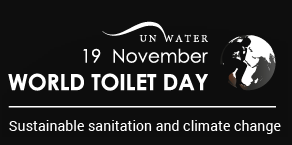World Toilet Day 2020, and the state of sanitation in India

Why in the news?
- The United Nations has been celebrating November 19 as World Toilet Day since 2013.
- This day is marked to spread awareness about sustainable sanitation, access to hygienic toilets and the human costs of unsafe sanitation.
What is sustainable sanitation?
- Sustainable sanitation begins with a toilet that effectively captures human waste in a safe, accessible and dignified setting. The waste then gets stored in a tank, which can be emptied later by a collection service, or transported away by pipework.
- The next stage is treatment and safe disposal. Safe reuse of human waste helps save water, reduces and captures greenhouse gas emissions for energy production, and can provide agriculture with a reliable source of water and nutrients.
Why is it necessary to raise awareness?
- 4.2 billion people live without access to safely managed sanitation. Instead they often use unreliable, inadequate toilets or practise open defecation.
- Untreated human waste gets out into the environment and spreads deadly and chronic diseases. Sustainable sanitation systems, combined with the facilities and knowledge to practise good hygiene, are a strong defence against COVID-19 and future disease outbreaks.
- It ensures to tackle the global sanitation crisis and achieve Sustainable Development Goal 6: water and sanitation for all by 2030.
- According to the World Bank: “A lack of sanitation also holds back economic growth. Poor sanitation costs billions to some countries”. Countries lose their GDP due to premature deaths, the cost of health care treatment, lost time and productivity seeking treatment, and lost time and productivity finding access to sanitation facilities.
What are the benefits of sustainable sanitation?
- In 2015, 68% of the world population had access to improved sanitation facilities. In other words, almost one-third of people did not have access.
- Open defecation leads to the deaths of 1,000 children every day globally from diarrhoea related to poor sanitation and contaminated water sources.
- Safe sanitation, water supply and better hygiene can save the lives of 3.5 lakh children in a year.
- According to the WHO, “every dollar spent on sanitation yields about $9 in savings on treatment, health-care costs and gains from more productive days.”
What is the state of sanitation in India?
- In India, only 40% of the population had access to improved sanitation. This is lower than countries like Sri-Lanka (95%), Bangladesh(60%) and Pakistan (60%).
- Improved sanitation is defined as facilities that “ensure hygienic separation of human excreta from human contact”. This includes facilities such as flush/pour flush (to piped sewer system, septic tank, pit latrine), ventilated improved pit (VIP) latrine, pit latrine with slab, and a composting toilet.
- According to Oxford University’s Our World in Data, poor sanitation, unsafe water sources, and no access to hand washing facilities are among the top factors in the country for deaths.
- Hence these issues need to be tackled and proper implementation of schemes such as Swatchh Bharat Abhiyan to have better ‘Improved Sanitation’.
References:
- https://indianexpress.com/article/explained/explained-world-toilet-day-2020-and-the-state-of-sanitation-in-india-7057610/
- https://www.who.int/news-room/events/detail/2020/11/19/default-calendar/world-toilet-day-2020-sustainable-sanitation-and-climate-change
- https://www.worldtoiletday.info/world-toilet-day-2020/world-toilet-day-2020-learn/
Subscribe
Login
0 Comments
